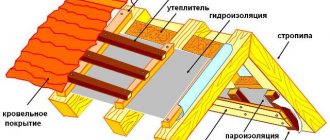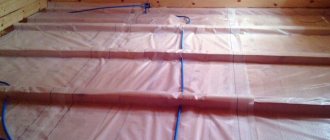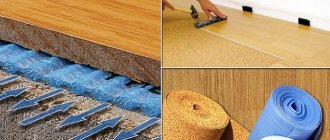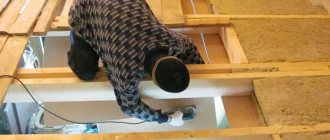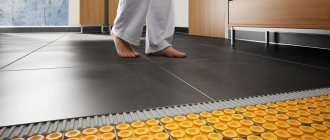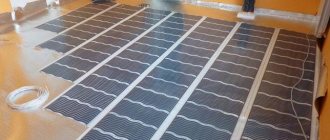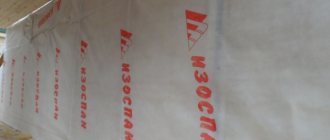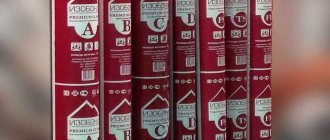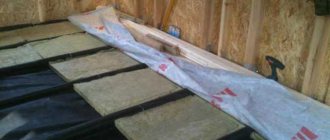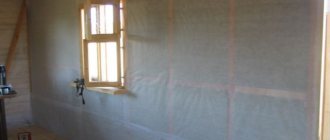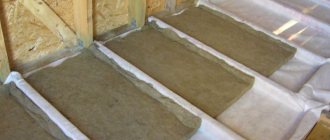With the development of technology, the requirements for housing comfort are increasing, which depends on many factors, including the state of the environment inside the home. Room temperature, air humidity, noise level, illumination - all these are components that characterize living conditions. Comfortable values of these parameters are achieved by using materials with appropriate characteristics in construction and finishing. At the same time, multifunctional materials provide not only comfortable living, but also the efficiency of using other special finishing products.
Let's consider the importance of performing a vapor barrier in a room, the modern vapor barrier material "Izospan", and how to lay isospan on the ceiling - the base that is in contact with steam more than other structures.
What is isospan
In rooms with high humidity or enclosing structures insulated with soft thermal insulation materials, a vapor barrier is required.
The simplest vapor protection of foundations is provided by a shell made of roofing material or polyethylene, which simultaneously serves as a waterproofing material. But such a primitive double-sided barrier does not allow moisture evaporating from the base material and insulation to pass out. In addition, drops of condensation formed on the film flow down or fall down without having time to evaporate, forming puddles on the floor and streaks on the walls.
Modern vapor barrier materials are much more functional; their varieties are produced for a specific task and therefore, while providing vapor protection, are free from the listed disadvantages.
By protecting the base from contact with condensate, the vapor barrier performs the following functions:
- protects the base from contact with condensate, preventing the formation of fungus;
- isolates the base insulation from external moisture, maintaining its thermal insulation properties;
- allows the water originally contained in the materials of the supporting structure and thermal insulation to evaporate;
- traps condensate, preventing it from draining and ensuring gradual evaporation.
An example of a modern vapor barrier material is the products that have been produced for 12 years by the domestic LLC Hexa - Nonwoven Materials under the brand name Izospan.
Izospan is a diffusion film or membrane made from modern polymers, produced using special technologies that make it possible to provide the varieties of this vapor barrier with certain characteristics, which, given the wide choice of insulating materials, facilitates the selection of a product with the desired functionality. The format and strength of isospan are designed in such a way that the installation of the vapor barrier shell can be carried out with optimal performance and quality.
Which side to put isospan B
When laying a vapor barrier membrane, many beginners wonder which side to lay the isospan on. To do this, before starting installation, it is recommended to carefully study the instructions and strictly follow its description. If the canvas is placed incorrectly, the thermal protection of the entire room will be compromised.
So, you should remember that Izospan B is always attached with the smooth side to the insulation. If the membrane has a foil surface, it should always face the inside of the room to reflect heat.
Thanks to its characteristics, Izospan B quickly gained recognition in the building materials market. It is used by both professionals and ordinary self-taught craftsmen for vapor barrier of premises of any design and purpose. The material reliably protects homes and industrial buildings from excess condensation, which is why load-bearing structures last longer and the insulation is used as efficiently as possible. In terms of the quality of membranes, the domestic product Izospan is not inferior to foreign analogues, and the moderate price pleasantly pleases the owner of the wallet.
Types, characteristics and applications of isospan
All types of isospan produced are made of polypropylene and are divided into 4 capacious lines, differing in characteristics and functionality:
- vapor-permeable, but waterproofing and wind-protecting membranes (5 classes - A, A with OZD - fire-retardant additives, AQ proff, AM, AS;
- films with vapor and waterproofing properties (6 classes - RS, B, C, RM, D, DM);
- energy-saving heat-steam-waterproofing materials with reflective coating (4 classes - FB, FS, FD, FX);
- adhesive tapes (7 types - KL, KL+, SL, FL, FL Termo, ML proff, SUL - self-adhesive sealing tape).
Materials of all varieties have the following common advantages:
- the required degree of vapor permeability;
- sufficient degree of tensile and bursting strength;
- environmental friendliness and safety - no harmful emissions;
- the presence in each group of fire-fighting varieties that have self-extinguishing properties;
- manufacturability due to elasticity, ease of cutting and optimal format for installation.
To simplify the overview of the varieties listed above, let's consider 4 types of isospan, the most widely used for vapor barrier - marked on the packaging as A, B, C and D. But this does not mean that other modifications of isospan are not suitable for vapor barrier - on the contrary, they either have higher performance, or designed for specific operating conditions. You just need to know how to choose and correctly lay these types of isospan on the ceiling.
Izospan type A
“Izospan A” is produced in two types – wall and roofing.
Roofing isospan-A is a wind- and moisture-insulating, but vapor-permeable membrane, laid between the roof insulation and its decking (metal tiles, cement-bonded particle board, ondulin). This shell is designed to prevent the formation of under-roof condensation, as well as to protect insulation and sloping roof structures of buildings with an inclination angle of more than 35 degrees from it.
The outer side of group “A” isospan is smooth, has water-repellent properties and is resistant to ultraviolet radiation. The structure of the inner surface of the membrane is voluminous, preventing the formation of condensation and allowing water vapor from the insulation to erode out.
A more advanced variety with a slightly lower vapor permeability value (at least 850 g/m2/day), but lighter and three times more water-resistant, is the Izospan AM vapor barrier.
Izospan type B
Izospan B is a universal two-layer protection of insulation and building structures from steam in the internal environment, which also has waterproofing properties. The material is laid on the inside of the heat-insulating layer of attic, basement and interfloor ceilings, as well as soft roofing. “Izospan-V” is placed with its smooth side facing the thermal insulation layer, and the rough outer surface with this arrangement helps to retain condensate on it with subsequent evaporation into the air of the room.
Izospan type C
“Izospan-S” is also a two-layer material for providing double-sided vapor and water protection for insulated coverings and floors, but its high strength allows the material to be used as a waterproofing layer on concrete, earthen and other insulated floors.
Izospan type D
This type of vapor-waterproofing isospan has increased strength, as it is made on the basis of polypropylene woven fabric. The high tensile strength characteristics of isospan-D make it possible to use this material to insulate building structures from the effects of atmospheric moisture from the outside, while the insulating coating can be exposed to even a static snow load.
Like “Izospan-S”, D-type vapor barrier can be used as a waterproofing shell on concrete and earthen floors, but its general application is hydro- and vapor barrier in two directions, protection from snow and wind of cold and insulated pitched roofs and wooden structures , as well as roofing covering from condensation from the inside.
Characteristics
Izospan b is a universal material for protecting metal structures from destruction and corrosion under the influence of factors such as moisture and condensation. The material protects buildings made of wood from fungal infection and rot from the inside. Vapor barrier membranes prevent moisture from penetrating the thermal insulation and stop the process of condensation. Thanks to these properties of the film, the required temperature is maintained in the room and no unnecessary heat loss occurs.
Izospan B has a number of useful characteristics: high water resistance, resistance to UV rays, protection from wind, reflection of heat flow, and assistance in free air exchange.
The membranes consist of two layers, one smooth and the other rough, specifically to contain condensation and allow it to evaporate unhindered.
The instructions from the manufacturer indicate Izospan b characteristics and features of the material of the following nature:
- density - 70 gr. per square meter;
- base - 100% polypropylene;
- tensile load - 128 N/5cm;
- vapor permeability -22 gr. per square meter per day;
- water resistance - 1200 mm water column;
- temperature range - from -60 to +80 degrees.
The description and technical characteristics of Izospan make it possible to preserve the original properties of the insulation for the maximum possible period, as well as extend the service life of premises of any type.
Common technologies for vapor barrier of ceilings with isospan
Vapor barrier of the ceiling base is carried out using one or a combination of several types of this vapor barrier, and the installation of any isospan on the ceiling can be done independently. The individual characteristics of the varieties of this vapor barrier material are indicated on the packaging, which makes it easier to select the protection of the desired class. When selecting the right brand of isospan, it is necessary to take into account the functionality of the ceiling (basement, interfloor or attic), its material, type of insulation and operating conditions of the room. The location of the vapor barrier shell relative to the base and insulation is also of great importance, since a correctly executed vapor barrier is also based on the orientation of the material used.
How to lay isospan on a concrete ceiling
When repairing the ceiling, an intermediate operation, performed after leveling with cement mixtures and before insulating the base from the inside, is waterproofing - in case of leakage from above, if there are highways or plumbing fixtures on the floor above. A layer of waterproofing applied to the ceiling from the room side using a coating method (deep penetration composition or bitumen-based) will simultaneously perform the function of vapor barrier, which is mandatory when using soft insulation. The coating method of waterproofing, which is not difficult to implement, eliminates the need to lay a layer of isospan-A on the ceiling, the waterproofing properties of which are also lower.
When installing thermal protection made of rigid insulation (polyurethane foam, expanded polystyrene) over waterproofing, there is no need to install a vapor barrier. But if mineral wool is used for insulation, especially when laid in a frameless manner (plastic fungi), then a vapor barrier is required - this insulation is hygroscopic and, in addition to reducing its thermal insulation qualities, will also “please” it by reducing its thermal insulation qualities.
Soft insulation is mounted on a waterproofed ceiling using plastic mushrooms in such a way that the fastener caps press the thermal insulation layer along with a vapor barrier made of isospan-B to the concrete base. Izospan is laid in strips with an overlap of 15 cm over each other, and on the ceiling - 5-10 cm down, with the smooth side towards the insulation. The edges of the overlaps are glued longitudinally with self-adhesive Izospan tape of FL or SL brands.
On the ceiling, the location of insulation sheets with fungi is first marked so that the longitudinal rows of fasteners are arranged in even parallel rows with the same spacing. Wooden slats treated with a hydrophobic compound are installed along the longitudinal rows of fungi, attaching them to plastic caps using self-tapping screws. Decorative plastic panels or siding can be laid across longitudinally mounted slats.
Laying isospan on the ceiling
Ceiling vapor barrier technology may include the installation of one or several layers of coating. In order to correctly lay isospan, it is necessary to take into account the following characteristics of the surface being treated:
- functional purpose of the insulated surface
- material of manufacture;
- expected load on the material in the form of moisture and steam.
Installation on concrete ceilings
Considering the fact that most concrete floors are coated with bitumen mastics, the use of isospan here will not be effective. However, when using soft insulation, vapor barrier must be present to extend their service life and improve technical characteristics.
Izospan is attached from the outside to a pre-prepared frame, while for installation on a concrete surface, plastic dowels are used. The frame can be wooden or galvanized sheathing, which serves as the basis for laying insulation, vapor barrier and facing material.
Installation on wooden ceilings
Insulating surfaces in a wooden house is one of the main tasks to improve its performance and quality characteristics. Izospan is used here regardless of the presence of insulation and is mandatory for use on both sides of the surface being treated. The laying process itself is not particularly difficult and any available methods can be used to secure the material to the surface.
Installation of isospan in the interfloor ceiling
If both floors are residential, that is, heated, the vapor barrier can be done using only one type of material - isospan-B, but it will be laid on both sides of soft insulation
When installing interfloor ceilings on load-bearing beams, rough ceiling boards are hemmed to them from below. Then, on the rough ceiling from the side of the upper floor, soft insulation is laid between the beams, the thickness of which should be 3-5 cm less than the cross-sectional height of the rafters. This difference in size is necessary so that after laying the vapor barrier film on top, a ventilation gap is formed between the isospan and the thermal insulation, necessary for weathering moisture from mineral wool.
Isospan-B is spread over the heat-insulating layer - with the smooth side towards the insulation. The vapor barrier film is attached to the beams with staples using a stapler, avoiding strong tension or sagging, with the strips overlapping each other by 10-15 cm, with the joints between each other and the walls being glued with connecting tape “Izospan-SL” or “-FL”.
Counter slats are nailed on top of the rafters along their entire length - wooden blocks with a cross section of 4x4 or 5x5 cm, across which the finished floor boards are laid.
Important! After finishing laying the finished floor, it is necessary to check and, if necessary, tamp down the rough ceiling boards from below, the fastening of which may become loose due to knocking on the rafters from above.
Then they begin to install the vapor barrier on the rough ceiling, which is done according to the same rules: using a stapler with staples across the ceiling boards, the volumetric side of the isospan-B towards the room, with an overlap of vapor barrier strips of 10-15 cm.
Upon completion of the vapor barrier device, finishing is performed foundations with siding.
We recommend visiting the company’s website for wholesale and retail sale of lumber https://www.realwood.ru/. Larch, pine, spruce. Quality products.
Why Izospan
This is not the first article we have devoted to the study of this material, so we will briefly discuss the main characteristics and scope of application.
Izospan B (V) is a two-layer non-woven material used to protect all types of structures, including floors, in any buildings. Prevents the formation of condensation and, as a result, the development of fungus. Retains dust and insulation fibers and serves as wind protection.
Membrane properties
Options
Indicators
Longitudinal stretch, mm
Transverse stretch, mm
Longitudinal tensile load, N/cm
Transverse tensile load, N/cm
It consists of two layers - the outer one is smooth for easy fastening, the bottom one is perforated to retain moisture. This difference in texture makes it easy to figure out which side to put Izospan to the insulation - with the bottom fleecy layer towards the place where condensation forms in order to constantly remove it.
Provided that a vapor barrier membrane is used, the structure is reliably protected from the formation of excess moisture, the accumulation of condensation on components and metal elements, rotting of wooden rafters and walls, etc. A side effect of using such a film is that it prevents insulation fibers, especially if it is mineral wool and especially glass wool, from entering the room.
VIDEO: Which side to lay steam and waterproofing
We understand the sides and fastening
Let us remind you once again which side to lay Izospan B - perforated towards the insulation, smooth outwards. Even if it is not possible to determine by touch which of them is rough, the marking - the name of the canvas is displayed on the smooth side, that is, when attaching it, you should see the name.
The inner side of the fabric is designed to absorb moisture
Front – smooth – side where the product name is printed
Installation of the Izospan material is carried out by one side or the other, depending on what material is used.
The membrane is always attached to load-bearing structural elements or to rough cladding or flooring. The canvas is secured with wooden slats or a construction stapler.
If lining, eurolining, plywood, etc. are used for finishing, the film is fixed with thin wooden slats parallel to each other. Insulation is inserted between the slats, in this case the smooth surface faces it.
When carrying out vapor barrier waterproofing of the roof, individual strips are attached overlapping each other (the overlap width is at least 10 cm) and fixed with double-sided tape, and the attachment point itself is additionally covered with vapor barrier tape. produces a whole line of adhesive tapes specifically for such needs.
Tape for gluing joints of vapor barrier Izospan V
It is clear that it is necessary to determine which side to lay Izospan in each specific situation, taking into account that its fleecy surface should absorb water, that is, it faces the place where the condensation will come from.
Application in certain areas
The use of a vapor barrier material greatly extends the service life of the insulation and, as a consequence, the entire building structure. Its main task is to prevent the penetration of condensate and the formation of fungus.
Insulated roof
A membrane or polyethylene film is a mandatory element when constructing an insulated roof. It is mounted on elements of the supporting frame, less often - on rough finishing. It is necessary to ensure that moisture formed due to temperature differences does not get on the insulation. To enhance the characteristics of the joints (overlapping), Izospan SL is glued.
It is laid with the smooth side against the insulation, regardless of its type - polystyrene foam, polystyrene foam, mineral wool, etc.
External wall insulation
The structure of the product is such that it is equally successfully used for both external and internal insulation. The main thing is that the film should not be exposed to direct sunlight - they significantly reduce the service life and generally have a negative effect on the canvas. For exterior finishing, the smooth side also faces the heat insulator.
Floor structures
Installation of Izospan is recommended when arranging interfloor and basement floors to isolate the insulation from moisture and at the same time to prevent its fibers from entering the living space.
Polyethylene is laid between the cladding and the rough ceiling with the perforated (reverse) side down and directly above the insulation itself, with the rough surface facing it.
Be sure to make a ventilation gap of 40-50 mm between the vapor barrier and the insulation for air circulation.
To ensure the tightness of the joints, it does not matter whether they use series B or FX; when they are laid end-to-end, they are glued with KL or SL tape.
Flooring
When laying any floor covering on a concrete, brick, cement or other base (with the exception of wood and its derivatives), be sure to lay a layer of vapor and waterproofing to compensate for temperature differences and absorb condensation. They lay the canvas directly on the screed, they can lay it with insulation if the decorative coating is thin, or they can immediately lay parquet or laminate on the base.
Installation instructions
In houses and premises where work is being done to insulate walls and roofs, the membrane sheet is attached to the supporting frame between the insulation and the rough finish, with the smooth side facing the insulation. For fixation, it is permissible to use galvanized nails with large heads so as not to tear them, or use a stapler - this is much more convenient and faster.
When working with inclined surfaces, cut the required size sheets in advance and fasten them horizontally from bottom to top with an overlap of 10-15 cm.
For further finishing with lining and other wooden panels, the film is fixed with wooden slats with an edge of 40 mm, pre-impregnated with an antiseptic.
When plasterboard is used for rough finishing of walls, the membrane is secured with staples or galvanized nails, with its smooth side facing the insulation and fitting as tightly as possible to it.
Installation of isospan when installing roof coverings
This situation differs from the previous one in that above the coating there is an external environment with all the accompanying factors - wind, rain, snow, etc. In addition, when choosing the type of isospan in this case, you should also take into account the roof structure, which can be flat or sloped.
Vapor protection of a wooden ceiling under a roof with a slope
Wooden slats with a cross-section of approximately 3x6 cm are placed across the roof rafters from below in increments of 0.5 m, on which soft insulation is laid on top. An additional sheathing of slats is placed on top of the insulation in order to lay a vapor barrier made of isospan-A on it. A-class isospan is designed to protect insulation and roof structures from wind, snow and rain, but its smooth surface is not laminated, as it is intended for use on roofs with a slope of more than 35 degrees, at which water drops roll down. Additional sheathing is performed to ensure this slope angle, so that such a film does not sag over time and does not let water through into the insulation.
It is spread over the sheathing and isospan-A is attached to it according to the method described above. Next, counter battens are sewn along the rafters, on top of which the sheathing for the outer roof covering is mounted.
On the inside of the covering, an isospan-B vapor barrier is spread and stapled onto transverse slats with a cross-section of 3x6 cm, on top of which the interior siding trim is mounted in the direction perpendicular to the location of the bars.
Thus, the soft insulation is insulated on both sides with different types of isospan, also providing a double-sided ventilation gap:
- Izospan-A protects insulation and structures from wind, sub-roof condensation, rain and snow, without preventing moisture from escaping in the opposite direction from the insulation and structural materials;
- Izospan-B insulates soft thermal insulation from moisture contained in the room air.
Vapor protection of a wooden ceiling under a flat roof
The design of the vapor barrier on the ceilings of this roof structure is somewhat different from the vapor barrier device of the previous type of coating. Since the smooth surface of isospan-AM is laminated, its strength and waterproofing characteristics are much higher than type A vapor barrier, therefore AM vapor barrier can be used when the roof slope is less than 35 degrees and even on flat bases. In this case, there is no need to install additional sheathing on top of the insulation - the strength of isospan-AM itself is sufficient, but for this it must be correctly laid, fastened and joined.
Recommendations for installation and use
Many questions arise for those who do not have the opportunity to build a house on their own and decide how to insulate their premises, what material to choose and what to do with the floor?
When the question arises about vapor barrier of an existing room with its own initial data, you need to take into account the condition of the ceiling. There are cases when owners stick isospan to a plastered ceiling and expect that condensation will not appear on the loggia or in another room, thanks to the magical properties of the membrane. They make a mistake in advance: isospan does not fit on structures that are already plastered or insulated with mineral wool.
Insulation of this kind does not require a vapor barrier, and plaster is already a type of interior finishing. Flooring will lead to consequences that will then have to be eliminated.
To insulate the roof from the outside, a different type of material, type A, is required. It will be installed according to different principles and reasons. And for insulating the roof from the inside of the room, the flooring technology remains the same.
Izospan in the attic type attic
If the film breaks during installation, you can seal it with construction tape. This must be done very carefully so that the sealed layer is not damaged later.
Izospan under galvanized profiles
In addition to vapor barrier of ceilings, similar work must be carried out on the floor or walls, but for this, completely different types of membrane film and technologies for its laying can be used. The main thing is to understand what type of film is needed for construction or repair work, so as not to purchase something that turns out to be unnecessary.
The use of isospan for ceilings is described in detail in the instructions for use. If you have doubts about the choice of material, it is best to consult with specialists. Installing isospan on the ceiling is easy to do yourself if you study the necessary information in advance.
Izospan B vapor barrier film is installed indoors. It is used for insulated roofs, floors, attic floors, and walls. The manufacturer's instructions and information about the material give you an idea of which side to turn the panel towards the heat insulator during the fastening process. The smooth surface always adheres to the thermal insulation, while the fibrous surface remains on the outside and stops moisture from steam, preventing it from penetrating inside the structure.
The vapor barrier is laid with an overlap of panels of 15-20 cm, installation is carried out from the bottom up. The connecting places require good sealing; for gluing, a specialized adhesive tape produced by the company and marked FL is used.
Izospan SL tape is also suitable. The areas adjacent to the structure, sheathing, utility holes and niches are sealed using self-adhesive sealing tape, which is simultaneously pressed against the protective sheet and the contacting surface.
Installation of the film when insulating a roof with an inclined surface is carried out according to the following scheme:
- the roll is cut into strips of the required size;
- the first strip is attached from below parallel to the floor, with the smooth part to the heat insulator;
- the next tape is installed, covering the fixed film by 15 cm;
- the panels are fixed with a stapler for construction work or with galvanized nails to the rafters of the building;
- the joints are covered with sealant using specialized SL tape;
- a frame frame is placed on top of the vapor barrier, forming a clearance of 40-50 mm;
- The cladding material is attached to the wooden slats.
Fastening Izospan B when insulating the floor (floor) occurs in stages:
- the canvases are laid with the rough side towards the base floor (ceiling);
- the places where they adjoin the surface of the walls and the joints of the tapes are coated with glue using SL tape;
- the heat insulator lies on a smooth film surface;
- waterproof Izospan C is laid on top;
- The floor covering is being installed.
When attaching a vapor barrier to internal walls and partitions, the panel is placed directly on the heat insulator and attached to wood slats. First of all, a frame frame is stuffed on top of the film, creating a gap for ventilation of at least 30 mm. During further gypsum cladding, installation is performed on a zinc profile.
The use of Izospan B, which protects the heat insulator and wall surface from moisture, extends the service life of thermal insulation and the entire structure of the building.
